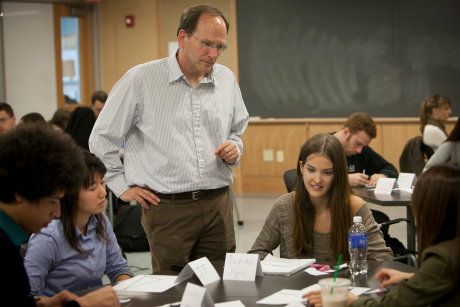Strogatz helps students find the magic in math
By Linda B. Glaser


Math, to a mathematician, is an aesthetic, creative endeavor. But for too many high school students, math has become a reviled, boring subject.
It doesn’t have to be that way, as Steven Strogatz aims to show the students in his new College of Arts and Sciences course, Mathematical Explorations. The course fulfills the math distribution requirement and has attracted seniors who put off taking a math class as long as they could, as well as freshmen intrigued by the course’s title.
“My goal for this class is to show how big and beautiful and interesting math is,” said Strogatz, the Jacob Gould Schurman Professor of Applied Mathematics. “I want students to have a feeling of pleasure from understanding something at a deeper level, to have the feeling of ‘aha!’ moments.”
The class is based on an engaged learning approach called inquiry-based learning, developed at Westfield (Massachusetts) State University. Before beginning his new class, Strogatz, in collaboration with Cornell’s Center for Teaching Excellence, arranged for Westfield instructors to do a workshop at Cornell, to which Cornell and Ithaca College faculty from math and engineering fields were invited; 51 professors attended.
Because his class is not a prerequisite for a higher math course, Strogatz aims for students to have “genuine math experiences,” rather than to master specific formulas. He uses hands-on activities extensively – like teaching symmetry through mirror dances -- and constantly challenges the students to think things through for themselves.
The class meets in the newly renovated Clark Hall Learning Suite, and the hexagonal tables make conversation easy for the four students at each; the room has plenty of space for exercises involving movement. A recent class opened with Strogatz giving each student a piece of paper with a scalene triangle (no equal sides) drawn on it and a pair of scissors. The day’s challenge was to prove a mathematical idea four different ways. The idea was simple: the angles of all triangles add up to 180 degrees (also described as adding up to a “straight angle”).
Cutting out triangle shapes might look like arts and crafts and not a college math class, said Strogatz, “but it really helps to approach math in the spirit of play. It’s OK to do something as crude as ripping the object you’re studying in pieces because it gives you ideas.”
And indeed, the students at Table 1 enthusiastically manipulated the ripped and cut pieces of triangle until they’d assembled them, surprisingly, into a line – showing that all the angles do, indeed, add up to a straight angle.
“Math magic!” exclaimed Rebecca Allen ’16, a fine arts and art history major.
Out of the 33 students in class that day, more than half spoke up during class discussions; no one got criticized or laughed at, and mistakes were encouraged.
“People talk about math as right or wrong, but it has an artistic dimension to the creative proofs,” explained Strogatz.
Conor Hodges ’18 said the class is “rehabilitating my approach to math. It’s very engaging.”
For English major Megan Flynn ’15, the class has made concepts she’d memorized in high school but didn’t understand “present in real life. Last week we used Cheez-Its to explain squares; seeing something as regular as Cheez-Its was weirdly enlightening, and that happens every class.”
At the end of class, Strogatz invited the students to ponder why there are 180 degrees in a straight angle. Is that something humanity discovered? Or invented? “The numbers are arbitrary but the ideas behind them aren’t,” responded Rush Imhotep ’15, Africana studies. “It’s like the human language: You make words to express them, but the expressions are real.”
The class applauded.
Linda B. Glaser is a staff writer for the College of Arts and Sciences.
Media Contact
Get Cornell news delivered right to your inbox.
Subscribe